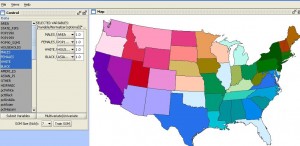Integrated Approach To Multivariate Analysis And Geovisualization Project Objective:
- To integrates computational, visual methods together to detect and visualize multivariate spatial patterns.
- To perform multivariate clustering and abstraction with a Self Organizing Map.
- To encode SOM result with colors derived from a two-dimensional color scheme.
- To visualize spatial variations of multivariate patterns.
- To support human interactions to explore patterns from different perspectives.
PROBLEM FORMULATION:
To build an integrated approach, it is necessary to examine the relations between different methods, which can be either complementary or competitive. Complementary methods usually analyze the data from different perspectives and help each other overcome weaknesses. For example, multidimensional visualization can be complemented by a cartographic map to explore multivariate spatial data interactively.
Computational and visual approaches are usually complementary to each other as the former process and summarize large data sets while the latter can help present and understand the findings . In contrast, competitive methods usually focus on the same analysis task. For example, two different clustering methods often produce different clusters from the same data due to different searching strategies or underlying constraints.
It would be useful and often critical to be able to compare the results of such competitive methods, find commonalities, examine differences, crosscheck each other’s validity, and thus better understand the data and patterns. Although there are considerable efforts on integrating complementary methods, few have focused on competitive approaches.
Applications:
- Image Processing
- Market Research
- World Wide Web
- Medical diagnostic
- Pattern Recognition
- Spatial Data Analysis
- Exploration of health survey data
- Visualization of patterns in census data

